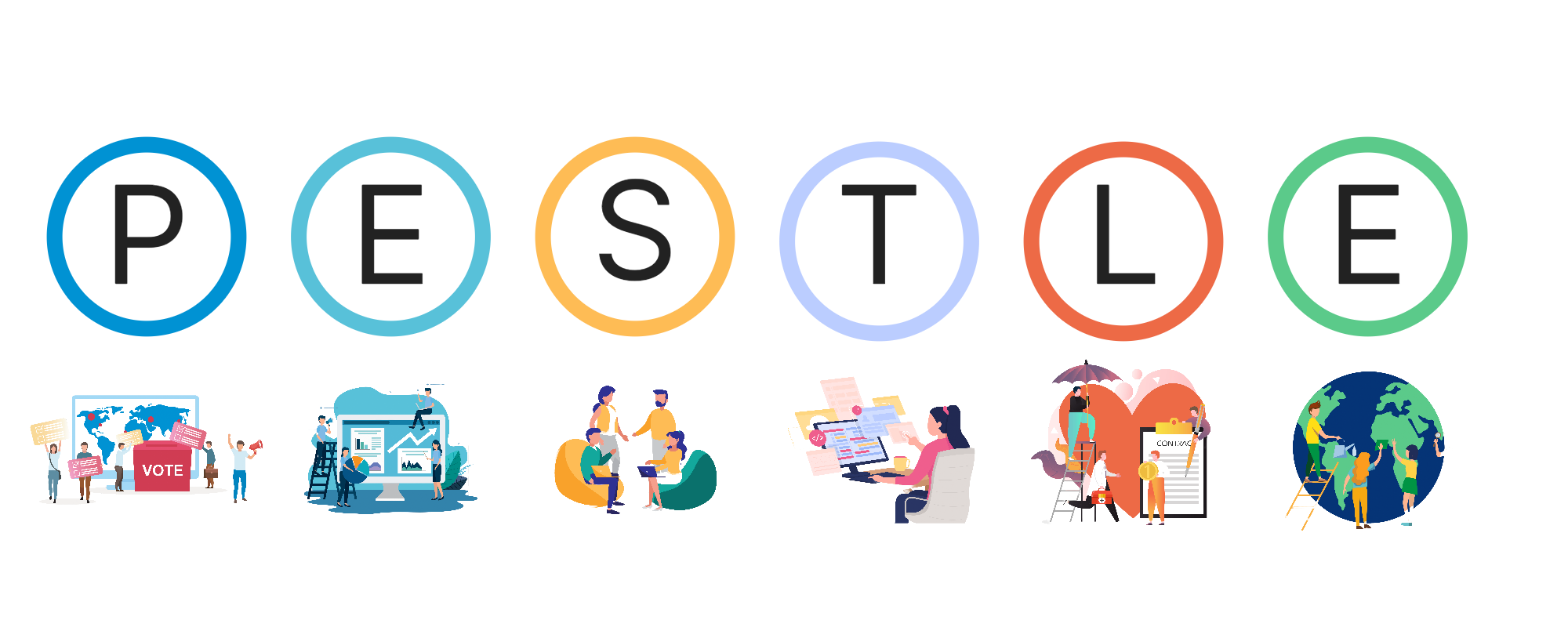Summary
Every organization, regardless of its size or industry, should consider the external environment. PESTLE model offers a framework to conduct an analysis of external factors. Identifying external factors not only helps organizations to assess risks but also create and gain competitive advantage.
In a world where uncertainty prevails and the operating environment is unstable, many service organizations must assess whether the current strategy adequately considers external factors affecting the organization's operations. It is clear that when organizations are in the midst of an uncertain and unstable global situation, matters must be examined more thoroughly. It is strongly reflected in the strategic decisions of service organizations as well.
I have noticed that external factors are often reviewed more carefully when an organization encounters a crisis. Few companies assess external factors in the early stages of business. A common reason is that the assessment is perceived as laborious and time-consuming, and its benefits may not be recognized when the business environment is stable.
Another noteworthy factor is that organizations may focus on examining only generally known external factors rather than directing the analysis toward external factors affecting their business and industry. It is evident that, for example, a restaurant and a software company operate in different environments, and external factors can significantly differ between them. Thirdly, the assessment of external factors is often limited to identifying these factors and it is not systematically conducted within the organization.
So, is there a model or method available for evaluating these external factors? I will now introduce one commonly known model for assessing these external factors and share thoughts on how the model could be concretely utilized.
PESTLE model in assessing external environment
The PESTLE model is commonly known as a framework used to assess external factors influencing an organization's external environment or operations [1]. The model is typically employed as part of an organization's strategy and risk management efforts. PESTLE is an abbreviation for political, economic, social, technological, legal, and environmental factors. These are elements that an organization often has little control over, but it should consider them as part of successful organizational operations. The model is also visible in service management as part of holistic approach [2].
The PESTLE model is based on the analysis of the environment and how it can assist in strategic decision-making and determining the organization's future direction. This idea was presented by Francis Aguilar.[3]
The first versions of the model focused on addressing political, social, and technological factors. Over the years, the model expanded and evolved into the form of PESTLE or PESTEL. Both expressions are used, but the idea remains the same.
There have been discussions about whether the current categorization is sufficient. Should, for example, information security have its own category, or can it be addressed as part of technological factors? There is no clear-cut answer to this. If information security is perceived as a critical component, it may be worthwhile to consider it as a separate entity.

PESTLE model factors
Listing all external factors would be highly time-consuming and laborious. That is why it is essential to focus on those external factors that impact your organization's business operations and operating environment. It is recommended that the analysis is conducted together with key stakeholders to gain a comprehensive understanding of the external factors essential for operations. One way to create a list is to use artificial intelligence in the early stages, which can identify, for example, the most common external factors in a specific industry. Afterward, the organization, together with stakeholders, can decide which of the listed factors are relevant or if there are missing factors that should be taken into consideration.
Examples from PESTLE model’s external factors in each category:
- Political
- Political or government decisions that affect the organizations operations
- Economic
- Economic growth
- Inflation
- Social
- Development of demographics, e.g. ageing population
- Culture
- Technological
- Technological innovations (AI, Metaversum, Web 3.0)
- R&D
- Legal
- Laws and regulation, e.g. GDPR, whistleblowing
- Environmental
- Sustainability requirements
- Green IT
How to utilize PESTLE model
How should the PESTLE model then be utilized? In addition to identifying and categorizing factors, the organization must have a clear plan on how it will consider these factors as part of its strategic work.
It's important to note that the PESTLE model focuses only on external factors, so it does not address internal factors that a successful organization should consider as part of its operations. When using the PESTLE model, it is also useful to utilize other strategic tools that support the organization's comprehensive strategic work. For example, SWOT analysis, forecasting tools, and scenario planning can provide deeper insights to support strategic decision-making, indicating how the organization can respond to external factors and identifying its strengths and weaknesses.
I have noticed that for international organizations with business units located geographically apart, it can make sense to examine factors from the perspective of each country, as the operating environments of different countries can vary significantly. Additionally, dividing factors into short and long-term categories can be useful in prioritizing and implementing strategic initiatives related to identified factors.
Next, I will briefly outline how a service organization can leverage the PESTLE model. The phased model is based on adapting the ideas described in the PESTLE model [1].
-
Identify and categorize the external factors into categories according to the PESTLE model. If necessary, use country-specific classification to support categorization, especially if the business is geographically distributed.
-
Once the external factors have been identified, determine each factor's impact and probability by scoring them. For example, a scale of 1-5, where 1 has minimal impact or probability, and 5 has a significant impact or probability.
-
Create a timeline indicating when the factors may impact the organization and develop a plan on how the organization intends to respond to these external factors.
-
Utilize other strategic tools, such as SWOT analysis, scenario planning, or forecasting, as part of the analysis work.
-
Regularly monitor and update external factors. This should be included in the strategy work of the organization and ownership of this process should be defined.
Another aspects related to PESTLE model
As previously mentioned, the PESTLE model is often used to consider the impact of external factors on organization's operations. Typically, the focus is on analyzing potential negative effects, and the primary attention is on internal operations.
Can the model also be used to identify changes in the operating environment that can help the organization gain a competitive advantage? The organization can consider whether the identified factors offer a significant competitive advantage as part of the analysis. For example, when the General Data Protection Regulation (GDPR) came into effect, some law firms had observed and prepared for the regulation in its early stages. These firms built ready-made services and increased their revenue because they were aware of what was happening in the surrounding world.
Another factor I have come to realize is that the success of some organizations strongly influences the success of other organizations or, in some cases, the functioning of the entire society. There are real-world examples of projects where the overall risk associated with the project was not identified, and the effects of the project's failure on the surrounding world were not accurately defined. In such cases, a failed project can, in the worst case, affect the providing of critical services for society. For example, a failure in implementing a new enterprise resource planning (ERP) system can affect not only the organization implementing the new ERP but also its customer organizations. So, when defining the external factors according to the PESTLE model, it is additionally vital to identify the dependencies between different organizations and the impact the dependency may have on the organization's operations.
Conclusion
Organizations should examine external factors affecting their operations in a rapidly changing world as part of strategic work. The PESTLE model is a valuable tool to support strategic decision-making. However, it's important to note that as an independent model, it may not be comprehensive enough, and it is recommended to use other strategic tools as well. As part of identifying external factors, artificial intelligence can be utilized to speed up heavy and time-consuming work. It is also crucial to remember that external factors should be regularly assessed and updated to align with the current business environment. This should be part of active monitoring and reviewing in the strategy work.
The PESTLE model can also be utilized in pursuing a competitive advantage and, on the other hand, as part of risk management, assessing the impacts of one's operations on the surrounding world.
In summary, here are a few key takeaways on how to successfully utilize the PESTLE model:
- Reflect on which factors are essential external factors for your organization.
- Develop a plan on how to incorporate these factors into the organization's strategy.
- Utilize other strategic management tools alongside PESTLE analysis to gain a comprehensive understanding.
- Consider whether external factors in the operating environment can help differentiate from competitors or potentially create new business and build new service concepts ahead of others.
- Regularly monitor, evaluate, and update PESTLE factors, linking them to the organization's strategic work.
References
[1]: Whittington, R., Regnér, P., Angwin, D., Johnson, G., & Scholes, K. (2020). Exploring strategy : text and cases (12th ed.). Pearson, 34-56.
[2]: Axelos (2019). Value for Stakeholders, PESTLE and the Four Dimensions
[3]: Aguilar, F.J. (1967). Scanning the Business Environment. MacMillan Co, New York.














Keskustelu